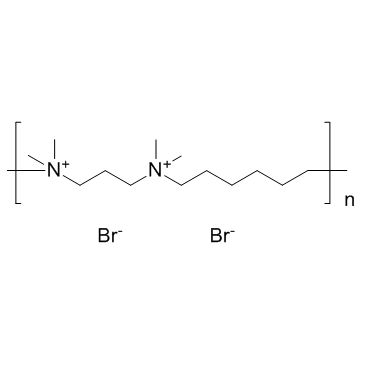Hexadimethrine bromide

Hexadimethrine bromide structure
|
Common Name | Hexadimethrine bromide | ||
|---|---|---|---|---|
| CAS Number | 28728-55-4 | Molecular Weight | 404.27 | |
| Density | N/A | Boiling Point | 209.5ºC at 760 mmHg | |
| Molecular Formula | C15H36Br2N2 | Melting Point | N/A | |
| MSDS | Chinese USA | Flash Point | 73.9ºC | |
| Symbol |

GHS07 |
Signal Word | Warning | |
Use of Hexadimethrine bromideHexadimethrine bromide is a cationic polymer discovered to enhance retroviral transduction. |
| Name | Sequa-brene |
|---|---|
| Synonym | More Synonyms |
| Description | Hexadimethrine bromide is a cationic polymer discovered to enhance retroviral transduction. |
|---|---|
| Related Catalog | |
| In Vitro | Hexadimethrine bromide inhibits human mesenchymal stem cell proliferation during lentiviral transduction. Hexadimethrine bromide is considered non-toxic at low concentrations, but has been found to negatively affect cell proliferation in some cell types at concentrations greater than 10 µg/mL. Trypsinized cells exposed to Hexadimethrine bromide are visibly larger in size when viewed under the microscope[1]. |
| Cell Assay | Trypsinized cells are washed and resuspended in medium at 2×104 cells/mL with or without rhFGF-2 (final concentration=10 ng/mL, PeproTech) and with or without Hexadimethrine bromide at a final Hexadimethrine bromide concentration of 1, 4, or 8 µg/mL. The different conditions are seeded in 96-well plates at 1×103 cells in 50 µL per well in triplicate and cultured at 37°C, 5% CO2. After 6, 9, or 24 hr, the medium is changed and subsequent medium changes occurred every 3-4 days with 50 µL of ± FGF-2 medium (10 ng/mL). Plates are harvested on day 4, 7, 14, and 21 by removing the medium and placing the plates in the -80°C freezer until the day of analysis. The CyQUANT assay is then performed on the wells[1]. |
| References |
| Boiling Point | 209.5ºC at 760 mmHg |
|---|---|
| Molecular Formula | C15H36Br2N2 |
| Molecular Weight | 404.27 |
| Flash Point | 73.9ºC |
| Vapour Pressure | 0.202mmHg at 25°C |
| InChIKey | KZKAYEGOIJEWQB-UHFFFAOYSA-N |
| SMILES | BrCCCBr.CN(C)CCCCCCN(C)C |
| Storage condition | 2-8℃ |
CHEMICAL IDENTIFICATION
HEALTH HAZARD DATAACUTE TOXICITY DATA
|
| Symbol |

GHS07 |
|---|---|
| Signal Word | Warning |
| Hazard Statements | H302 |
| Personal Protective Equipment | Eyeshields;Gloves;type N95 (US);type P1 (EN143) respirator filter |
| Hazard Codes | Xn: Harmful; |
| Risk Phrases | R20/21/22 |
| RIDADR | UN 2811 |
| RTECS | TQ2655000 |
| Packaging Group | III |
| Hazard Class | 6.1(b) |
|
NSC-87877 inhibits DUSP26 function in neuroblastoma resulting in p53-mediated apoptosis.
Cell Death Dis. 6 , e1841, (2015) Dual specificity protein phosphatase 26 (DUSP26) is overexpressed in high-risk neuroblastoma (NB) and contributes to chemoresistance by inhibiting p53 function. In vitro, DUSP26 has also been shown to... |
|
|
Polyomavirus T antigens activate an antiviral state.
Virology 476 , 377-85, (2015) Ectopic expression of Simian Virus 40 (SV40) large T antigen (LT) in mouse embryonic fibroblasts (MEFs) increased levels of mRNAs encoding interferon stimulated genes (ISGs). The mechanism by which T ... |
|
|
Polybrene: Observations on cochlear hair cell necrosis and minimal lentiviral transduction of cochlear hair cells.
Neurosci. Lett. 600 , 164-70, (2015) Polybrene is widely used to enhance viral transduction; however, little is known about the utility thereof, in enhancing lentiviral transduction of cochlear cells. In the present study, we examined th... |
| Hexadimethrine bromide,Polybrene |
| HEXADIMETHRINE BROMIDE |
| 1,5-Dimethyl-1,5-diazaundecamethylene polymethobromide,Polybrene |
| MFCD00133397 |